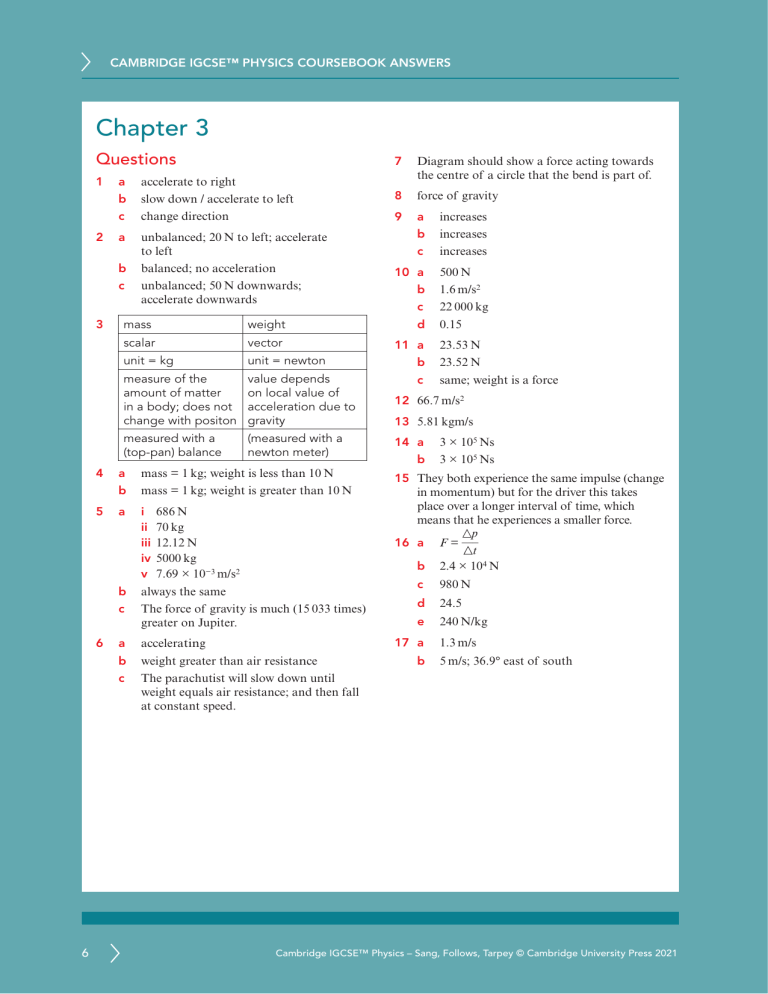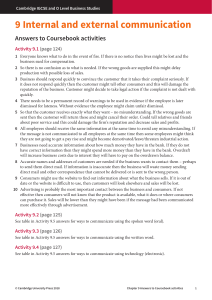
CAMBRIDGE IGCSE™ PHYSICS COURSEBOOK ANSWERS Chapter 3 Questions 1 2 a b c accelerate to right slow down / accelerate to left change direction a unbalanced; 20 N to left; accelerate to left balanced; no acceleration unbalanced; 50 N downwards; accelerate downwards b c 3 mass weight scalar vector unit = kg unit = newton measure of the amount of matter in a body; does not change with positon value depends on local value of acceleration due to gravity measured with a (top-pan) balance (measured with a newton meter) 4 a b mass = 1 kg; weight is less than 10 N mass = 1 kg; weight is greater than 10 N 5 a i 686 N ii 70 kg iii 12.12 N iv 5000 kg v 7.69 × 10−3 m/s2 always the same The force of gravity is much (15 033 times) greater on Jupiter. b c 6 6 a b c accelerating weight greater than air resistance The parachutist will slow down until weight equals air resistance; and then fall at constant speed. 7 Diagram should show a force acting towards the centre of a circle that the bend is part of. 8 force of gravity 9 a b c 10 a b c d 11 a b c increases increases increases 500 N 1.6 m/s2 22 000 kg 0.15 23.53 N 23.52 N same; weight is a force 12 66.7 m/s2 13 5.81 kgm/s 14 a b 3 × 105 Ns 3 × 105 Ns 15 They both experience the same impulse (change in momentum) but for the driver this takes place over a longer interval of time, which means that he experiences a smaller force. p 16 a F = ___ t b 2.4 × 104 N c 980 N d 24.5 e 240 N/kg 17 a b 1.3 m/s 5 m/s; 36.9° east of south Cambridge IGCSE™ Physics – Sang, Follows, Tarpey © Cambridge University Press 2021 CAMBRIDGE IGCSE™ PHYSICS COURSEBOOK ANSWERS Exam-style questions 1 C; [1] 2 C; [1] 3 A; [1] 4 C; [1] 5 a F = ma; [1] b 2.5 m/s2; [1] c 14 s; [2] d Graph with time on the x-axis and speed on the y-axis. [1] Straight line drawn from (0, 0) through (14, 35); [1] e 245 m; [1] f change direction; [1] a p = mv; [1] b 1079 kg m/s; [1] c 7.35 × 103 N; [2] d For a given change in momentum, seat belts and the crumple zones increase the time it takes for the car passengers to come to a stop, [1] which reduces the force on them. [1] In turn, this reduces the potential injuries; [1] 6 7 Cambridge IGCSE™ Physics – Sang, Follows, Tarpey © Cambridge University Press 2021



